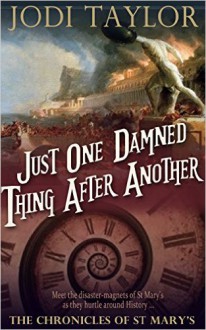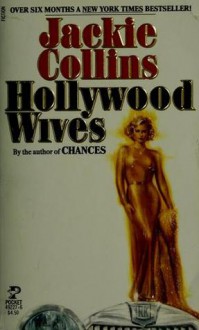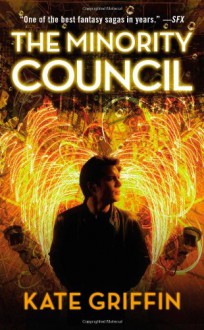
Madeleine Maxwell has had two pivotal moments in her life to date. Her second moment arose after a former teacher suggested applying for a job as a Historian at St. Mary’s Institute of Historical Research. During the interview, St. Mary’s is cagey about the exact nature of their work, but once Maxwell accepts the job, she discovers they are historians who use time travel to correct historical inaccuracies. St. Mary’s has a certain eccentricity about it that appeals to her own rebellious nature:
“We finished with a tour of the grounds… Even as I opened my mouth to ask, there was a small bang from the second floor and the windows rattled.
‘Hold on,’ said Chief Farrell. ‘I’m duty officer this week and I want to see if the fire alarms go off.’
They didn’t.
‘That’s good, isn’t it?’ I said.
He sighed. ‘No, it just means they’ve taken the batteries out again.’”
The story follows Maxwell as she undertakes orientation at St. Mary’s, trains as a time-traveler, and is challenged by her initial missions. As she and her fellow orientees embark on their first missions, the peril of time traveling becomes evident. As the Director points out to her:
“Think of History as a living organism, with its own defence mechanisms. History will not permit anything to change events that have already taken place. If History thinks, even for one moment, that that is about to occur, then it will, without hesitation, eliminate the threatening virus. Or historian, as we like to call them.”
Maxwell is fun character with a contagious humor and enthusiasm. Virtually without vanity, after changing into her new grey trainee jumpsuit, she notes, “Surveying myself in a mirror, I looked like a small, excited, ginger sack.” Interestingly, there is minimal personal background, except to learn that it was troubled, and books were a way out. It’s an interesting authorial choice, as it has the advantage of avoiding infodumping and tying the book to a particular point in time, but increases the challenge of creating a sympathetic, multidimensional person. However, her winning combination of spunk, personality and sass won me over. And the ability to hold her liquor. Usually.
There’s loads of humor in the book, creating chuckles all the way through. A scene where the Director is rebuking the staff for their flippant answers on their personnel files had me laughing out loud. Rather than one-note witticisms, humor here comes in many forms, from the mad-cap situations, to sly references (“thick as two short Plancks”) to generally clever writing:
“I cut him off with a gesture and a complicated, ambiguous noise intended to convey–if you don’t ask then I won’t have to lie and you won’t have to take any action we might both regret, because, let’s face it, I’m not the only one up to no good here.
We both paused to contemplate the massive rule-breaking going on here.
‘Would you like some tea?’
‘Oh. Yes, please.’“
I encountered one significant problem while reading, however, I have to apologize to Taylor and say, “It’s not you, it’s me.” As I am tremendously fond of To Say Nothing of the Dog by Connie Willis, comparisons between Willis’ and Taylor’s books were inevitable. Similarities included (vague spoilers, natch):
philosophically similar time traveling institutes focused on historical investigation, not exploitation; historians known for their nutty behavior; a wardrobe/costuming department; the concept of historians being unable to effect history; and the same penultimate discovery. But more important than conceptual parallels is a similar daffy sense of adventure and humor running through the book, with a little bit of star-crossed character leads.
(spoiler show)
That said, Taylor’s plot is considerably more action-focused, along with a heavy focus on institutional dynamics.
Other concerns include a bit of vagueness on our present-day setting. This may well be intentional as a way to keep the storyline more focused on the plot, but I did wonder what exact time period the setting is. There’s reference to email, the “latest electronic retrival system” in the library, an “electronic scratchpad” for note-taking, GPS, “blasters,” and “transporters” that take the trainees away from St. Mary’s. It led me to guess mostly-current era, with a suspicious lack of cell phones/instantaneous communication that might have made a later plot point preventable.
The other concern with mentioning for those that like the science part of the science fiction seems a little light. Pure speculation would be that Taylor’s strength is the history part of the story rather than the science details. For instance, although they travelers “can’t bring anything back,” they can apparently return covered in mud and potentially contagious with disease. Willis acknowledges the disease/contagion problem in her series and deals with it in an interesting way, but the paradox hasn’t seem to occur to Taylor’s historians though they have to decontaminate before exiting the pod. Also, although they are “forbidden” from interacting with locals, they end up doing it with some regularity, so it opens up those pesky time-line questions, which are promptly ignored. I’m not one that cares about timeline/causation generally (‘therein lies madness’) but it’s worth mentioning for those who might notice the logic gaps. My most significant final concern is some forced and questionably authentic relationship drama that seemed somewhat out of character for both parties involved. While I appreciated the resolution, it had a false note to it that seemed like character was sacrificed for some plot tension.
But all those are relatively small concerns, given that its ability to hold my interest. It was literally one of those books that I did not want to put down and will certainly hold my attention for a second read. Overall, it was an amazing first novel. A shout out to Richard at Expendable Mudge Muses whose enthusiasm and whole-hearted recommendation inspired me to read this book (and the next, naturally).
A final, memorable line: “It seemed very possible we would all be killed by idiots rather than villains, which would be typical.“


 Log in with Facebook
Log in with Facebook 









